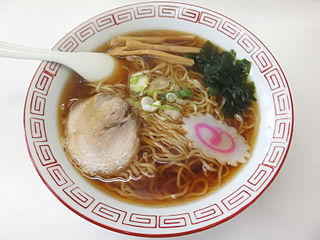
Ramen is a Japanese noodle dish. It consists of Chinese-style wheat noodles served in a broth; common flavors are soy sauce and miso, with typical toppings including sliced pork, nori, menma, and scallions. Ramen has its roots in Chinese noodle dishes. Nearly every region in Japan has its own variation of ramen, such as the tonkotsu ramen of Kyushu and the miso ramen of Hokkaido.
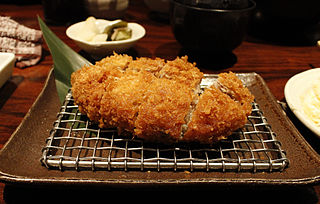
Tonkatsu is a Japanese dish that consists of a breaded, deep-fried pork cutlet. It involves coating slices of pork with panko, and then frying them in oil. The two main types are fillet and loin. Tonkatsu is also the basis of other dishes such as katsukarē and katsudon.

Okonomiyaki) is a Japanese teppanyaki, savoury pancake dish consisting of wheat flour batter and other ingredients cooked on a teppan. Common additions include cabbage, meat, and seafood, and toppings include okonomiyaki sauce, aonori, katsuobushi, Japanese mayonnaise, and pickled ginger.

Saimin is a noodle soup dish common in the contemporary cuisine of Hawaii. Traditionally consisting of soft wheat egg noodles served in a hot dashi garnished with diced green onions and a thin slice of kamaboko, modern versions of saimin include additional toppings such as char siu, sliced Spam, sliced egg, or shredded nori. When Chinese dumplings are added to the noodle soup, it is seen on menus as the heartier wonton min. All saimin establishments have their own, often secret recipe for the soup base, but primarily use kombu and dried shrimp as major ingredients. Common table condiments mixed in the saimin broth are Chinese hot mustard and soy sauce, added in small quantities according to each individual's taste. Many local residents of Hawaii also enjoy barbecued teriyaki beef sticks (skewers) or American hamburgers as a side dish.
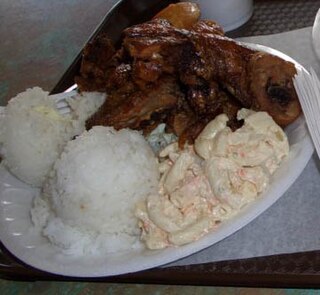
The plate lunch is a quintessentially Hawaiian meal, roughly analogous to Southern U.S. meat-and-threes. However, the combination of American and pan-Asian influence makes the plate lunch unique to Hawaii.
Loanwords from the Japanese language in Hawaiʻi appear in various parts of the culture. Many loanwords in Hawaiian Pidgin derive from the Japanese language. The linguistic influences of the Japanese in Hawaii began with the first immigrants from Japan in 1868 and continues with the large Japanese American population in Hawaiʻi today.
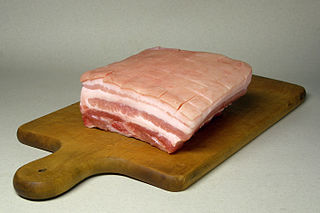
Pork belly or belly pork is a boneless and fatty cut of meat from the belly of a pig. Pork belly is particularly popular in Filipino, Hispanic, Chinese, Danish, Norwegian, Korean, and Thai cuisine.

Loco moco is a dish featured in contemporary Hawaiian cuisine. There are many variations, but the traditional loco moco consists of white rice, topped with a hamburger, a fried egg, and brown gravy. Variations may include bacon, ham, Spam, tofu, kalua pork, Portuguese sausage, teriyaki beef, teriyaki chicken, mahi-mahi, shrimp, oysters, and other meats.
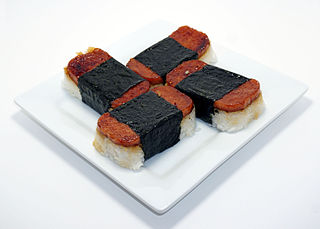
Spam musubi is a snack and lunch food composed of a slice of grilled Spam sandwiched either in between or on top of a block of rice, wrapped together with nori in the tradition of Japanese onigiri.

Chanpurū (チャンプルー) is an Okinawan stir fry dish. It is considered the representative dish of Okinawan cuisine. Chanpurū generally consists of tofu combined with some kind of vegetable, meat, or fish. Luncheon meat, egg, moyashi and gōyā are some other common ingredients. Spam is not typically used in mainland Japan; but it is more common in Okinawa due primarily to the historical influence of its introduction by the US Navy. Chanpurū is Okinawan for "something mixed" and the word is sometimes used to refer to the culture of Okinawa, as it can be seen as a mixture of traditional Okinawan, Chinese, mainland Japanese, Southeast Asian and North American culture. The term originates from the Malay and Indonesian word campur, meaning "mix".

Taco rice is a popular example of modern Okinawan cuisine. It consists of taco-flavored ground beef served on a bed of rice, frequently served with shredded cheese, shredded lettuce, tomato and salsa.
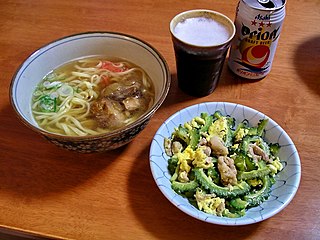
Okinawan cuisine is the cuisine of the Okinawa Prefecture of Japan. The cuisine is also known as Ryūkyūan cuisine, a reference to the Ryukyu Kingdom. Due to differences in culture, historical contact between other regions, climate, vegetables and other ingredients, Okinawan cuisine differs from mainland Japanese cuisine.
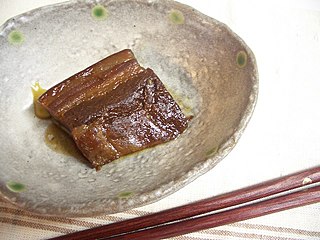
Kakuni (角煮) is a Japanese braised pork dish which literally means "square simmered".
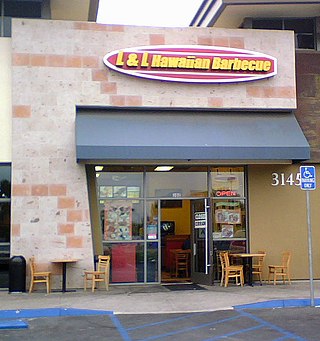
L&L Hawaiian Barbecue, known also as L&L Drive-Inn or colloquially as L&L, is a Hawaiʻi-themed franchise restaurant chain based in Honolulu, Hawaiʻi, centered on the plate lunch.

Japanese cuisine has a vast array of regional specialities known as kyōdo ryōri (郷土料理) in Japanese, many of them originating from dishes prepared using local ingredients and traditional recipes.

Nimono is a simmered dish in Japanese cuisine. A nimono generally consists of a base ingredient simmered in shiru stock & seasoned with sake, soy sauce, and a small amount of sweetening. The nimono is simmered in the shiru over a period of time until the liquid is absorbed into the base ingredient or evaporated. The base ingredient for a nimono is typically a vegetable, fish, seafood, or tofu, or some combination of these. The shiru stock for a nimono is generally dashi. Other than sake and soy sauce, the stock can be further flavored by mirin, sugar, salt, vinegar, miso, or other condiments.

Tonkotsu ramen (豚骨ラーメン) is a ramen dish that originated in Fukuoka, Fukuoka Prefecture on the Kyushu island of Japan, and it is a speciality dish in both Fukuoka and Kyushu. The soup broth is based on pork bones and other ingredients, which are typically boiled for several hours, and the dish is traditionally topped with chāshū and served with ramen noodles that are hard in the center. In Fukuoka, tonkotsu ramen is referred to as Hakata ramen.

Okazu-ya or okazuya in Hawaii are often referred to as a Japanese "delicatessen". Unlike western delicatessens found in North America or Europe, an okazuya is an establishment that sells readymade Japanese-styled food. "Okazu" refers to a side dish to accompany rice, while "ya" refers to a retail establishment.



























